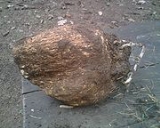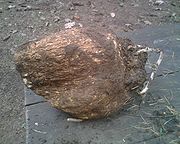
Wolfiporia extensa
Encyclopedia

Polyporaceae
The Polyporaceae are a family of bracket fungi belonging to the Basidiomycota. The flesh of their fruiting bodies varies from soft to very tough. Most members of this family have their hymenium in vertical pores on the underside of the caps, but some of them have gills The Polyporaceae are a...
family. It is a wood-decay fungus
Wood-decay fungus
A wood-decay fungus is a variety of fungus that digests moist wood, causing it to rot. Some wood-decay fungi attack dead wood, such as brown rot, and some, such as Armillaria , are parasitic and colonize living trees. Fungi that not only grow on wood but actually cause it to decay, are called...
but has a terrestrial growth habit. It is notable in the development of a large, long-lasting underground sclerotium
Sclerotium
A sclerotium is a compact mass of hardened fungal mycelium containing food reserves. One role of sclerotia is to survive environmental extremes. In some higher fungi such as ergot, sclerotia become detached and remain dormant until a favorable opportunity for growth. Other fungi that produce...
that resembles a small coconut. This sclerotium (called "Tuckahoe", or Indian bread) was used by Native Americans
Indigenous peoples of the Americas
The indigenous peoples of the Americas are the pre-Columbian inhabitants of North and South America, their descendants and other ethnic groups who are identified with those peoples. Indigenous peoples are known in Canada as Aboriginal peoples, and in the United States as Native Americans...
as a source of food in times of scarcity. It is also used as a medicinal mushroom in Chinese medicine.
Common names: hoelen, poria, tuckahoe, China root, fu ling (茯苓), fu shen (or fushen), matsuhodo.
Synonyms
Wolfiporia extensa (Peck) Ginns, Mycotaxon 21: 332 (1984) Wolfiporia cocos (F.A. Wolf) Ryvarden & Gilb., Mycotaxon 19: 141 (1984)Macrohyporia extensa (Peck) Ginns & J. Lowe, Can. J. Bot. 61(6): 1673 (1983) Macrohyporia cocos (Schwein.) I. Johans. & Ryvarden, Trans. Br. mycol. Soc. 72: 192 (1979) Poria cocos (F.A. Wolf), J. Elisha Mitchell
Elisha Mitchell
Elisha Mitchell was born in Washington, Connecticut. As a professor at the University of North Carolina at Chapel Hill, in 1835, he measured the height of Mt. Mitchell. Mt. Mitchell is the highest point east of the Mississippi River. It is located in North Carolina and is 6,684 feet high...
scient. Soc. 38: 134 (1922)
Daedalea extensa (Peck), Ann. Rep. N.Y. St. Mus. 44: 21 (1891) Pachyma cocos (Fr.), Syst. mycol. (Lundae) 2(1): 242 (1822)
Sclerotium cocos (Schwein.), Schr. naturf. Ges. Leipzig 1: 56 (1822)
Use in Chinese medicine
Called Fu Ling, it is collected between July and September. The poria with reddish inner side of the superficial layer is called red poria and the poria with white inner side of the superficial layer is called white poria. The poria produced in Yunnan ProvinceYunnan
Yunnan is a province of the People's Republic of China, located in the far southwest of the country spanning approximately and with a population of 45.7 million . The capital of the province is Kunming. The province borders Burma, Laos, and Vietnam.Yunnan is situated in a mountainous area, with...
is famous and therefore the drug is also called Yunnan poria Yunling). After collection, it is dried in shade, sliced, and used unprepared.
The mushroom is sweet and tasteless in flavor, neutral in property, acting on the heart, spleen and kidney channels. The mushroom is used for inducing diuresis, excreting dampness, invigorating the spleen, replenishing the middle-jiao, and tranquilizing the mind.
Uses according to Chinese medicine
1. For dysuria, edema, phlegm retention and others due to retention of water within the body, it is often used with umbellate pore and water-plantain tuber,as in Powder of Five Drugs Including Poria (Wuling San). Since poria is neutral in property, it can be used for damp-heat and cold-damp syndromes in combination with other drugs. In cases of damp-heat syndrome, it is often used with plantain seed and manshurian aris-tolochia stem; or cold-damp syndrome, it is usually used with lateral root of acon-ite and dried ginger; for dizziness, palpitation, cough, and so on due to retention of phlegm, it is often used with cinnamon twig and white atractylodes, as in Decoction of Poria, Cinnamon Twig, Atractylodes and Licorice (Ling GuiZhu Gan Tang).2. For lassitude, anorexia and loose stool due to deficiency of the spleen, it is always used with dangshen, white atractylodes and licorice, known as Decoction of Four Noble Drugs (Sijinzi Tang).
3. For fright palpitation and insomnia due to insufficiency of the spleen and heart, it is often used with dangshen,longan aril and wild jujube seed, asin Decoction for invigorating the spleen and nourishing the heart (Guipi Tang). For fright palpitation and insomnia due to phlegm retention in the interior or due to breakdown of the physiological coordination between the heart and kidney, it is often used with grass-leaved sweetflag and polygala root, as in Sedative Bolus(Anshen Dingzhi Wan).
Dosage and administration: 10-15g, decocted in water for an oral dose.
See also
- Medicinal Mushrooms: Their Therapeutic Properties and Current Medical Usage with Special Emphasis on Cancer Treatments by Cancer Research UKCancer Research UKCancer Research UK is a cancer research and awareness charity in the United Kingdom, formed on 4 February 2002 by the merger of The Cancer Research Campaign and the Imperial Cancer Research Fund. Its aim is to reduce the number of deaths from cancer. As the world's largest independent cancer...
(the American equivalent to the US National Cancer InstituteNational Cancer InstituteThe National Cancer Institute is part of the National Institutes of Health , which is one of 11 agencies that are part of the U.S. Department of Health and Human Services. The NCI coordinates the U.S...
), 2001.http://sci.cancerresearchuk.org/labs/med_mush/med_mush.html

